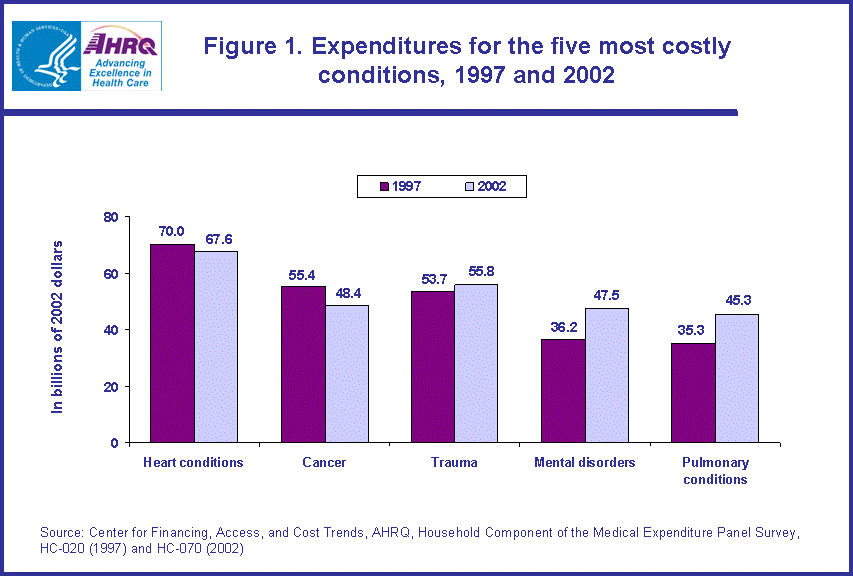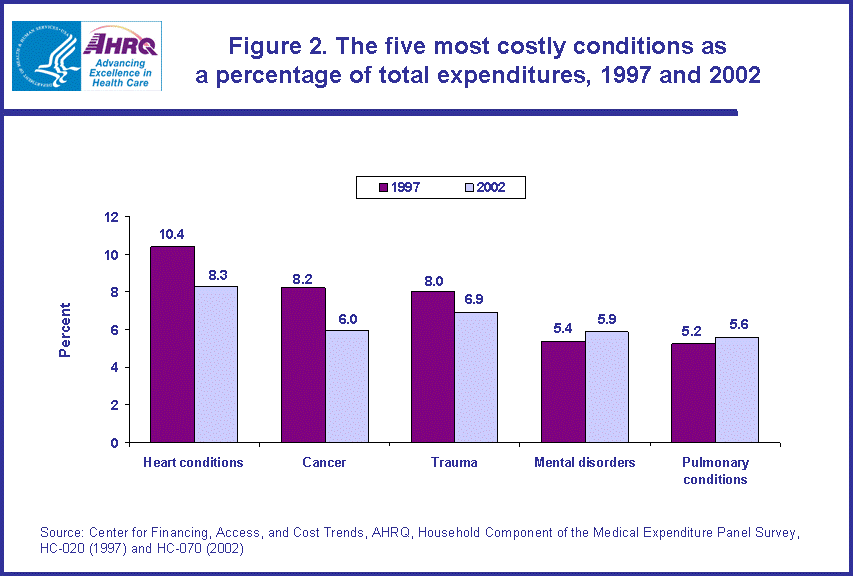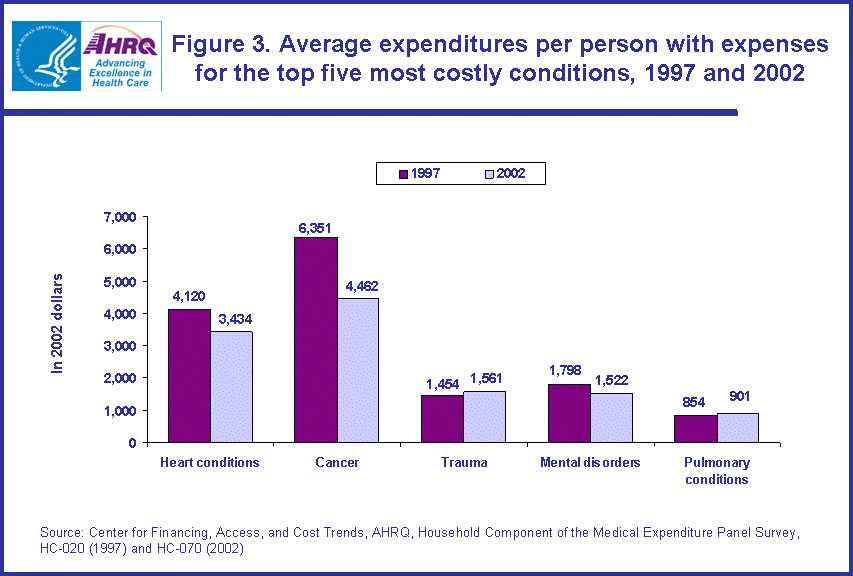
|
|
Font Size:
|
||||
|
|
|
|
||||
STATISTICAL BRIEF #80:
The Five Most Costly Medical Conditions, 1997 and 2002: Estimates for the U.S. Civilian Noninstitutionalized Population
Highlights
- Five medical conditions--heart conditions, cancer, trauma, mental disorders, and pulmonary conditions--ranked higher than all other medical conditions in terms of direct medical spending in 1997 and 2002.
- Medical expenditures (in 2002 dollars) increased the most for mental disorders ($11.3 billion) and pulmonary conditions ($10.0 billion) between 1997 and 2002.
- A comparable pattern was observed in 1997 and 2002 for the mean medical expenditures per person with expenses for medical events associated with the five most costly medical conditions. Among these top five conditions, the mean expenditure was highest for cancer and heart conditions and lowest for pulmonary conditions in both years.
Introduction
The Household Component of the Medical Expenditure Panel Survey (MEPS-HC) provides critical information for evaluating trends in health care expenditures. This Statistical Brief presents data from the MEPSHC concerning medical expenditures for the five most costly medical conditions in 1997 and 2002 for the U.S. civilian noninstitutionalized (community) population. These five conditions--heart conditions, cancer, trauma, mental disorders, and pulmonary conditions--were determined by totaling and ranking the expenses for the medical care delivered for the diagnosis and treatment of acute and chronic conditions. Only differences between estimates that are statistically significant at the 0.05 level are discussed in the text.
Findings
In terms of health care expenditures, the five most costly chronic diseases and acute conditions affecting the U.S. community population in 1997 and 2002 included heart conditions, cancer, trauma, mental disorders, and pulmonary conditions. During this period, medical expenditures (in 2002 dollars) increased the most for mental disorders ($11.3 billion) and pulmonary conditions ($10.0 billion). (figure 1)
In 1997, the largest share of total medical expenditures (in 2002 dollars) was for heart conditions (10.4 percent), cancer (8.2 percent), and trauma (8.0 percent). In 2002, the share of total health care expenditures for cancer was 6.0 percent, comparable to the shares for mental disorders (5.9 percent) and pulmonary conditions (5.6 percent). (figure 2)
A comparable pattern was observed in 1997 and 2002 for the mean medical expenditures per person with expenses for medical events associated with these five most costly medical conditions. Among the top five, the average was highest for cancer ($6,351 and $4,462) and heart conditions ($4,120 and $3,434) and lowest for pulmonary conditions ($854 and $901) in 1997 and 2002, respectively. Average medical expenditures for people with expenses for mental disorders ($1,798 and $1,522) and trauma ($1,454 and $1,561) were less than for cancer and heart conditions but more than for pulmonary conditions ($854 and $901) for 1997 and 2002, respectively. (figure 3)
Between 1997 and 2002, the number of people with medical expenses increased for all of the top five medical conditions except trauma. The largest percentage increase during this period was for mental disorders (55.0 percent, 20.1 to 31.2 million), followed by cancer (24.3 percent, 8.7 to 10.9 million) and pulmonary problems (21.7 percent, 41.3 to 50.2 million). (figure 4)
Data Source
The estimates shown in this Statistical Brief are drawn from analyses conducted by MEPS staff from the 1997 and 2002 Full Year Consolidated Data Files, HC-020 and HC-070, respectively, which are available on the MEPS Web site http://www.meps.ahrq.gov/.
Definitions
Medical conditions
Conditions data were collected from household respondents during each round as verbatim text and coded by professional coders using the International Classification of Diseases, Ninth Revision (ICD-9). Condition categories for this Statistical Brief were constructed using AHRQ's Clinical Classification Software (CCS), which aggregates ICD-9 codes into clinically meaningful categories. Categories were collapsed when appropriate. Decisions about collapsing CCS categories were based on maintaining the clinical significance of categories, the ability of household respondents to report the condition accurately, and the frequency of reporting the condition. CCS codes were aggregated into the following categories: heart conditions, 96, 97, 100-108; cancer, 11-45; trauma, 225-236, 239, 240, 244; mental disorders, 65-75; and pulmonary conditions, 127-134.*
Expenditures
Expenditures refer to what is paid for health care services. More specifically, expenditures in MEPS-HC are defined as the sum of direct payments for care provided during the year, including out-of-pocket payments and payments by private insurance, Medicaid, Medicare, and other sources. Payments for over-the-counter drugs and for alternative care services are not included in MEPS-HC total expenditures. Indirect payments not related to specific medical events, such as Medicaid Disproportionate Share and Medicare Direct Medical Education subsidies, are also not included.
Expenditure estimates for 1997 were inflated to 2002 dollars using the medical consumer price index (http://www.bls.gov/cpi/home.htm#data). Expenditures may be associated with more than one condition and are not unduplicated in the condition totals; summing over conditions will double-count some expenses. Total spending does not include other medical expenses, such as durable and nondurable supplies, medical equipment, eyeglasses, ambulance services, and dental expenses, because they could not be linked to specific conditions.
About MEPS-HC
MEPS-HC is a nationally representative longitudinal survey that collects detailed information on health care utilization and expenditures, health insurance, and health status, as well as a wide variety of social, demographic, and economic characteristics for the civilian noninstitutionalized population. It is cosponsored by the Agency for Healthcare Research and Quality and the National Center for Health Statistics.
For more information about MEPS, call the MEPS information coordinator at AHRQ (301-427-1656) or visit the MEPS Web site at http://www.meps.ahrq.gov/.
References
For a detailed description of the MEPS-HC survey design, sample design, and methods used to minimize sources on nonsampling error, see the following publications:
Cohen, J. Design and Methods of the Medical Expenditure Panel Survey Household Component. MEPS Methodology Report No. 1. AHCPR Pub. No. 97-0026. Rockville, Md.: Agency for Health Care Policy and Research, 1997.
Cohen, S. Sample Design of the 1996 Medical Expenditure Panel Survey Household Component. MEPS Methodology Report No. 2. AHCPR Pub. No. 97-0027. Rockville, Md.: Agency for Health Care Policy and Research, 1997.
Cohen, S. Design Strategies and Innovations in the Medical Expenditure Panel Survey. Medical Care, July 2003: 41(7) Supplement: III-5-III-12.
Suggested Citation
Olin, G. L., and Rhoades, J. A. The Five Most Costly Medical Conditions, 1997 and 2002: Estimates for the U.S. Civilian Noninstitutionalized Population. Statistical Brief #80. May 2005. Agency for Healthcare Research and Quality, Rockville, Md. http://meps.ahrq.gov/mepsweb/data_files/publications/st80/stat80.shtml
Footnote
* Cohen, J. and Krauss, N. Spending and Service Use among People with the Fifteen Most Costly Medical Conditions, 1997. Health Affairs, 22(2):129-138, 2003.
 |
||||||||||||||||||||||||||||||
|
||||||||||||||||||||||||||||||
|
|
||||||||||||||||||||||||||||||
 |
||||||||||||||||||||||||||||||
|
||||||||||||||||||||||||||||||
|
|
||||||||||||||||||||||||||||||
 |
||||||||||||||||||||||||||||||
|
||||||||||||||||||||||||||||||
|
|
||||||||||||||||||||||||||||||
 |
||||||||||||||||||||||||||||||
|
||||||||||||||||||||||||||||||
|
|
||||||||||||||||||||||||||||||


